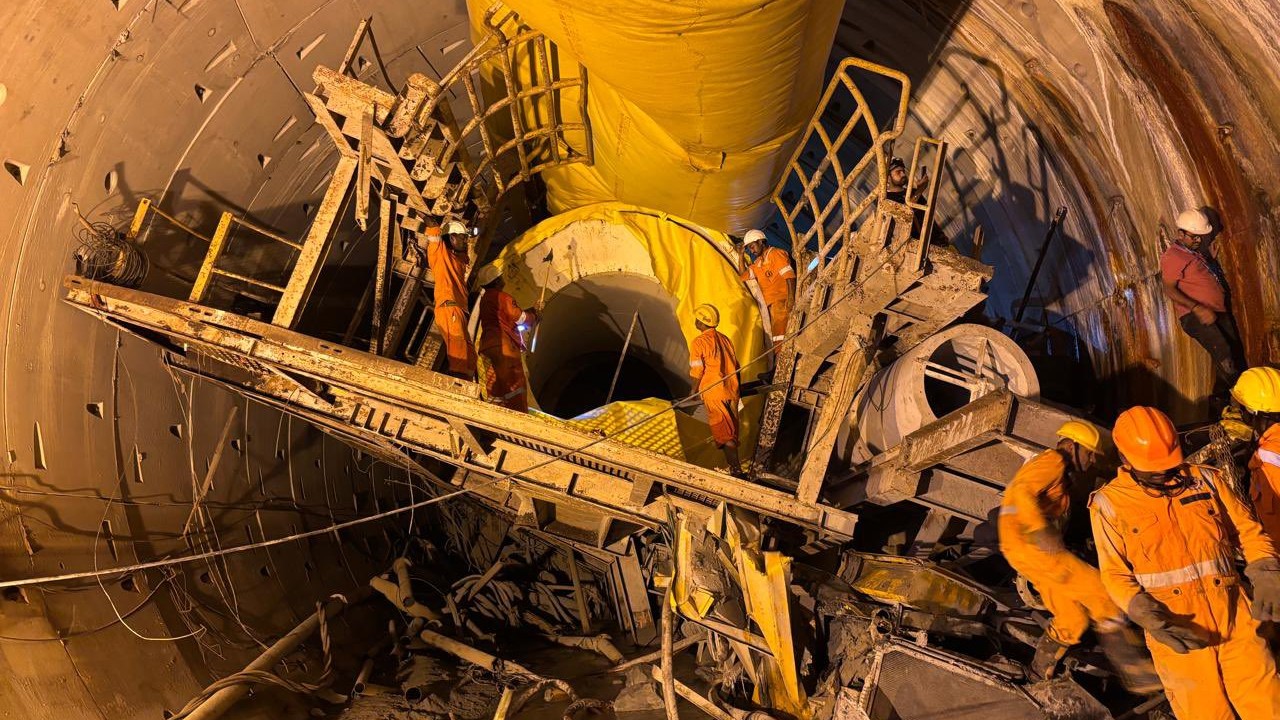On the eighth day of the operation, scientists from the National Geophysical Research Institute (NGRI) used Ground Penetrating Radar (GPR) to detect four bodies at a depth of two meters.
Published Mar 02, 2025 | 1:19 PM ⚊ Updated Mar 02, 2025 | 9:56 PM

Ongoing rescue operations at the SLBC tunnel. (Supplied)
Synopsis: Officials have confirmed that all eight workers, trapped following the Srisailam Left Bank Canal tunnel collapse, are presumed dead. Chief Minister A Revanth Reddy is expected to visit the site and hold a review meeting with officials regarding the rescue and recovery operation. Efforts to retrieve these bodies are in progress and expected to conclude by Sunday evening.
The ongoing rescue operations at the Srisailam Left Bank Canal (SLBC) tunnel collapse site in Telangana entered the ninth day on Sunday, 2 March. It has now transitioned into a recovery mission.
Officials have confirmed that all eight missing workers are presumed dead, with continuous water seepage posing significant challenges to the rescue teams. A foul smell inside the tunnel has further reinforced the grim reality.
Chief Minister A Revanth Reddy is expected to visit the site on Sunday evening and hold a review meeting with officials regarding the rescue and recovery operation.
On the eighth day of the operation, scientists from the National Geophysical Research Institute (NGRI) used Ground Penetrating Radar (GPR) to detect four bodies at a depth of two meters.
Efforts to retrieve these bodies are in progress and expected to conclude by Sunday evening. However, another four bodies have been located at a depth of seven meters, making their recovery significantly more challenging. According to the National Disaster Response Force (NDRF), it is currently impossible to retrieve these deeper bodies due to the tunnel’s unstable conditions and ongoing risks.
Forensic and medical teams have been deployed at the site, and ambulances are ready to transport the retrieved bodies to their respective villages. Families of the trapped workers remain on-site, anxiously awaiting closure.
The workers have been identified as:
The rescue teams, with the help of specialised equipment, are meticulously removing silt and mud to access the victims. Efforts have been intensified with additional personnel and resources being deployed at the identified locations.
The damaged conveyor belt, which was impacted by the collapse, is expected to be repaired by Monday. Once restored, it will facilitate a more efficient removal of debris from the tunnel. Officials have confirmed that dewatering and excavation efforts will continue around the clock.
State Excise Minister Jupally Krishna Rao stated that while four workers are likely to be retrieved by tomorrow night, the remaining four are buried deeper beneath the tunnel boring machine, making their recovery more complex.
“The situation inside the tunnel is critical, which is why the government is taking so much time. The chances of survival for those trapped inside are 99 percent unlikely, though we cannot completely rule out that one percent,” said Jupally Krishna Rao.
In a statement released on Saturday night, the State Disaster Management Department revealed that 18 organisations, 54 officials, and 703 personnel are actively engaged in the rescue efforts.
As authorities work tirelessly to retrieve the bodies and bring closure to the families, the SLBC tunnel collapse stands as a stark reminder of the risks faced by workers engaged in large-scale infrastructure projects.
(Edited by Muhammed Fazil.)
